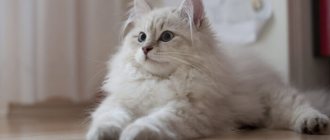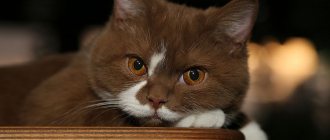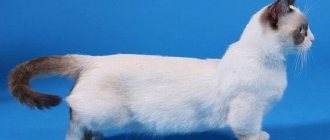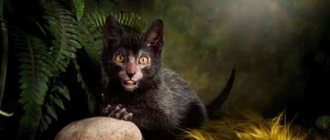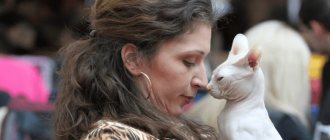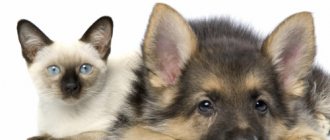Selkirk Rex
The Selkirk Rex breed appeared in 1987 in Montana (USA). In 1992, TICA was officially recognized.
Selkirk Rex
To create them, breeders used exotic, British and Persian cats.
Cats can be either short-haired or long-haired. The latter have especially pronounced curls on the collar and tail.
The coat is soft, silky, and curls chaotically. Any color is acceptable. With increased air humidity, curls become more expressive.
Habits are soft, friendly, measured.
Advantages
- playful;
- affectionate;
- unobtrusive;
- attentive.
Flaws
- arrogant;
- cunning.
Maintenance requires more careful care of the coat. When combing, the curls may straighten. Stiff metal combs must be used. It should not be given to people with allergies.
Bathing - no more than once every 2-3 months. It is important to regularly keep your eyes, ears, and mouth clean.
Breed standards and photos
The main distinguishing feature of the breed is its short, curly coat, which lies very tightly to the skin. Because of it, the graceful light body of cats looks even more graceful. The legs and tail appear extremely long and thin, although they are already longer than standard cat proportions. The tarsus (the forward part of the legs) are very small. The average weight of males is 3.5-4.5 kg, females - 3-3.5 kg.
The body is medium in size, the body is elongated. The back is curved in a smooth arc, the muscles of the shoulders, hips and legs are very developed. The head is small, graceful, elongated, with a hump on the nose (in the American type) or ovoid in shape. The muzzle is narrow, the cheekbones are high and chiseled, the profile line is slightly curved, the ears are large and set high. The eyes are very expressive, oval.
The movements of the Cornish are smooth, graceful, and bewitching. The fur does not hide, but rather emphasizes the work of the muscles during walking, running and jumping. American Cornish look like a refinement of European ones.
The wool is silky, soft to the touch, and very pleasant to touch. The curls are uniform and form smooth waves. On the belly, neck and lower part of the muzzle the hair is shorter than on the rest of the body, but does not form bald spots anywhere and completely hides the skin.
The color can be any, the most common are:
- white,
- black,
- cream,
- ginger,
- blue.
There are solid, bicolor, tricolor, tan and smoky colors, and options with a tabby pattern. White markings are acceptable. Eye color can be amber, blue, green, tea - it depends on the color of the coat.
Breed faults include: creases in the tail, extra toes, and the presence of coarse guard hairs.
Laperm
Laperm appeared accidentally in 1982 in Dallas, Oregon (USA) due to a mutation in the gene responsible for wool. These cats first took part in the exhibition in 1992. Then breeding work began to strengthen the characteristics and in 2002 TICA recognized the breed.
The name of the breed comes from the English. “perm”, meaning perm.
The coat is long and curls in light, expressive waves. There are short-haired individuals - they have coarse hair. Any color is acceptable. The kitten is born hairless and begins to grow hair within the first 4 months.
Lamperm
The character is sociable, inquisitive.
Advantages
- active;
- good-natured;
- funny.
Flaws
- annoying;
- demanding.
The content does not require tricks. You need to comb it regularly 1 – 2 times a week.
Maintain hygiene of the mouth, ears, and eyes.
Little-known breeds with curly hair
The list of cats with wavy hair can be continued with breeds that have not yet received official recognition by all felinological systems:
Skookum or dwarf laperm
The curly-haired breed was created by crossing a Laperm with a Munchkin. From Laperms, Skookums got a curly coat with a rich collar, and from Munchkins they got short legs. This is a very expensive and rare breed, which can only be found in nurseries in Western Europe.
Danish Rex
The peculiarity of the Danish Rex is that kittens are born with curly fur. But as they grow older, it changes to straight hair: thin and sparse. Only the mustache remains curled.
Oregon rex
The mutation was discovered in America (Oregon). This is an exotic and rare variety of curly-haired cats. After the discovery of such animals, a breeding boom began. Other curly-haired breeds were brought from Europe for crossing. The result is that the true Oregon Rex has lost its features. The rock has eroded. Today, finding real Oregon Rex cats is very rare.
Bohemian (Czech) Rex
Rexoids have been repeatedly discovered among the Persian breed. But breeding was not carried out on their basis due to their not very neat appearance due to their long hair and difficult care for it. The only exception is the Czech Curly Cat or Bohemian Rex. Outwardly, he is a Persian, but curly. The curls are very pronounced on the stomach, back and sides. Bohemian Rexes are distinguished by fluffy trousers on the hips and a collar. The breed was bred in Liberec (Czech Republic). Very rare. Finding a kitten is difficult even in the Czech Republic itself.
Dutch Rex
Cats with hard, curly fur have also been identified in Holland. According to one version, these are descendants of the American Wirehair cat. According to the second (main) - Maine Coons. Initially, curly-haired Maine Coon kittens were culled. But they were too interesting, so they began to work with cats to develop a separate breed - the Dutch Rex or Maine Coon Rex. However, there is little information about this breed of curly-haired cat and currently there is no targeted breeding.
Skookum
Skookum was created in 1996 in Washington State (USA) by Roy Galusha by crossing a Munchkin and a Laperm. Further Europe, Australia and New Zealand took part in the breeding program. This species was recognized as experimental in 2006 by TICA. It is distinguished not only by its curliness, but also by its short limbs.
The coat is soft and can be long or short. The longer it is, the more it curls. The color can be any.
Vibrissae (sensitive hairs - mustache, eyebrows) are necessarily curly.
Skookum
Cats are brave and good-natured.
Advantages
- affectionate;
- not noisy;
- playful;
- confident;
- funny.
Flaws
- stubborn;
- demanding.
Content. It is necessary to comb regularly (1 - 2 times a week) and bathe (1 time every 1.5 - 2 months). Use cosmetics intended for animals. Keep eyes, ears, teeth clean. Representatives of the breed are not afraid of water. Bathing becomes enjoyable for both the cat and the owner.
Devon Rex
This breed appeared in the 1960s in England. Scientists decided to study the curly-haired cats accidentally spotted in Devonshire more carefully. Work has begun to strengthen the features. Over time, the Devon Rex was officially registered.
The coat is short and lies in pronounced waves over the body. Pleasant to the touch, soft. Any color is acceptable.
The character is light and lively.
Advantages
- smart;
- affectionate;
- faithful;
- inquisitive;
- unpretentious.
Flaws
- do not get along well with other animals;
- annoying;
- prone to overeating.
Care consists of frequent bathing - from weekly to monthly (the schedule is selected individually for each cat).
You also need to pay special attention to cleaning your ears.
Devon Rex
Cats are not suitable for inactive people. The Devon Rex's coat is quite sparse and almost does not cause allergies.
Cornish Rex
The gherkin originated in 1950 in England. Gradually, information began to appear about such curly-haired pets around the world. Geneticists launched a program to strengthen the characteristics and in 1967 the Cornish Rex was officially recognized.
The coat has no guard hairs, is short, soft, and thick. Appears in waves, especially pronounced near the spine. Rarely causes allergies. The color can be any.
Cats of this breed have a sociable, cheerful character.
Gherkin
Advantages
- playful;
- brave;
- devotees;
- intellectual;
- inquisitive;
- not vindictive.
Flaws
- annoying;
- do not tolerate loneliness well;
- independent.
Care involves paying attention to temperature conditions. Cats do not tolerate drafts well, especially after bathing.
Otherwise, there are no special instructions for keeping this breed - maintaining hygiene, standard treatments for parasites.
Hypoallergenic
Although many breeds of curly-haired cats are considered hypoallergenic, this is not always true. Therefore, it is worth consulting not only with the breeder, who may be unscrupulous, but also with a veterinarian. After all, allergens are contained not only in fur, but also in saliva, urine, and animal skin. It is worth considering the origin of these breeds and remembering their parents. And if you have an allergy, you should think it over several times, weighing the pros and cons.
Cats with curly hair are gaining more and more popularity, and the number of people wishing to purchase such an interesting pet is constantly increasing. And this is no coincidence. They are truly incredibly beautiful. But not only the appearance attracts breeders, but also the unique character that is inherent in absolutely all these cats. They are very affectionate, obedient, love all family members and will become excellent friends for kids. But you should buy such a kitten only if it is possible to give him the same thing in return. These pussies need affection, love and understanding.
Ural rex
The first information about such cats appeared in the 30s and 40s in Russia. In the 60s, the first cat belonging to the breed, Vasily, became known, born in the Sverdlovsk region. A few representatives of this breed descended from him. Little common in other countries.
Ural rex
The coat is generally short, hard, has no undercoat, and lies in curled curls. The color can be any.
They shed less hair than most cats, making it easier to clean the house.
It also rarely causes allergies.
Representatives of the breed have pleasant habits.
Advantages
- understanding;
- unobtrusive;
- smart;
- sociable;
- affectionate;
- playful.
Flaws
- not suitable for inactive people.
Due to its peculiarity, wool requires careful care. It is necessary to trim (pluck), especially during the molting period.
You should bathe less frequently than other breeds. You need to monitor the condition of your skin. Otherwise, maintain hygiene as standard.
Hermann rex
The Herman Rex has been descended from the Cornish Rex since the 1950s. However, there is evidence that German rexes existed as early as the 1920s. The species is rare, distributed only in Germany, Finland and Switzerland. Some associations do not recognize it as separate.
The coat is short, the curls are wavy and sticking out. Has no guard hairs, soft.
Density varies from medium to very dense. Any colors are available.
Herman rex
Advantages
- pedantic;
- affectionate;
- inquisitive;
- sensitive;
- patient.
Flaws
- annoying;
When caring, it is important to brush regularly with a soft brush. Bath once every 1.5 – 3 months. It is not advisable to use dry shampoo. It is necessary to keep the mouth, eyes, ears, and claws clean.
Character and habits
Cornish Rex are peaceful, emotional and sensitive. They easily capture the subtlest shades of mood, are affectionate, but unobtrusive, and treat all family members with special tenderness. The person who cares about them the most is chosen as the owner. They need kind treatment and attention, and if they are treated rudely, they become very upset and offended.
They do not like noise and parties with many guests. The greatest pleasure for them is to be in silence next to the owner and his family. They love to sit on their laps or climb on their shoulders, hug their necks with their paws and “ride” a person around the apartment, watching with interest all his actions.
Cornish Rex dogs have high intelligence and excellent intuition. They easily make friends with other pets and are careful when playing with children. They do not scratch, even if a child inadvertently causes them pain.
Moderately playful, calm, meow quietly and rarely, more often they purr. They suffer from long-term loneliness and do not tolerate familiarity. Such cats need to be treated gently and respectfully; you cannot punish them or even raise your voice at them, because they cannot bear it very well.
Bohemian rex
Originated in the 1980s in Czechoslovakia from Persian cats. Previously, felinologists did not recognize these cats as a separate breed. Selection work has begun. In 1994, some associations registered the breed.
The coat is long, fluffy, soft. Lays down in waves. The collar is pronounced. Any color can be used.
Cats have a gentle character.
Bohemian rex
Advantages
- affectionate;
- devoid of aggression;
- calm;
- tender.
